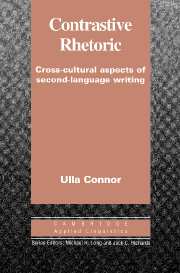Book contents
- Frontmatter
- Contents
- Series editors' preface
- Preface
- I PRELIMINARIES; EARLY PHASES OF THE FIELD
- II INTERFACES WITH OTHER DISCIPLINES
- 4 Contrastive rhetoric and the field of rhetoric and composition
- 5 Contrastive rhetoric and text linguistics
- 6 Writing as an activity embedded in a culture
- 7 Contrastive rhetoric and translation studies
- 8 Genre-specific studies in contrastive rhetoric
- III IMPLICATIONS OF CONTRASTIVE RHETORIC
- References
- Author index
- Subject index
8 - Genre-specific studies in contrastive rhetoric
Published online by Cambridge University Press: 05 October 2012
- Frontmatter
- Contents
- Series editors' preface
- Preface
- I PRELIMINARIES; EARLY PHASES OF THE FIELD
- II INTERFACES WITH OTHER DISCIPLINES
- 4 Contrastive rhetoric and the field of rhetoric and composition
- 5 Contrastive rhetoric and text linguistics
- 6 Writing as an activity embedded in a culture
- 7 Contrastive rhetoric and translation studies
- 8 Genre-specific studies in contrastive rhetoric
- III IMPLICATIONS OF CONTRASTIVE RHETORIC
- References
- Author index
- Subject index
Summary
Contrastive rhetoric studies of the 1960s, 1970s, and early 1980s focused on expository essay writing by ESL students. In the 1980s, however, student essays written for other aims, such as narration and argument, were analyzed cross-culturally. More recently, contrastive rhetoric has expanded to examine other modes and domains in addition to student writing. For example, important cross-cultural research examines writing in academic and workplace situations for specific tasks, such as the writing of research reports and abstracts, articles, grant proposals, and business letters. This chapter examines the relevant concept of genre. Then the findings of contrastive rhetoric studies are reviewed in three domains: student writing at the primary, secondary, and college level; academic writing; and professional writing, a category that includes political writing. Finally, how students learn to write in an academic environment is discussed.
The concept of genre
In the 1990s, the concept of “genre” has become a significant issue in applied linguistics. Dissatisfied with linguistic and rhetorical definitions such as Biber's (1988) linguistic analysis or Kinneavy's (1971) rhetorical study, experts in genre analysis have defined genre as a linguistic realization of some social activity. Perhaps Swales's (1990b) genre analysis, developed for the examination and teaching of academic discourse, has become best known. Swales's analysis is based on the examination of constituent parts or “moves” in written academic writing, especially the organization of the content of research papers. Another approach to genre is that of Berkenkotter and Huckin (1993).
- Type
- Chapter
- Information
- Contrastive RhetoricCross-Cultural Aspects of Second Language Writing, pp. 126 - 150Publisher: Cambridge University PressPrint publication year: 1996



